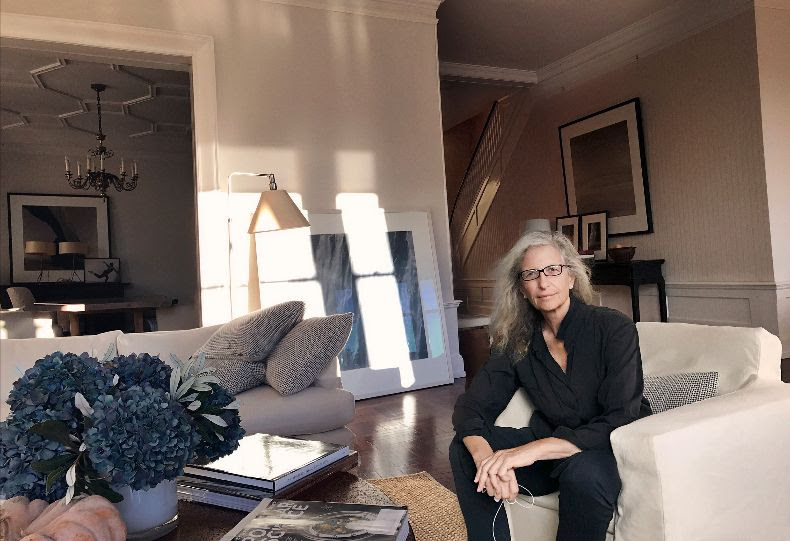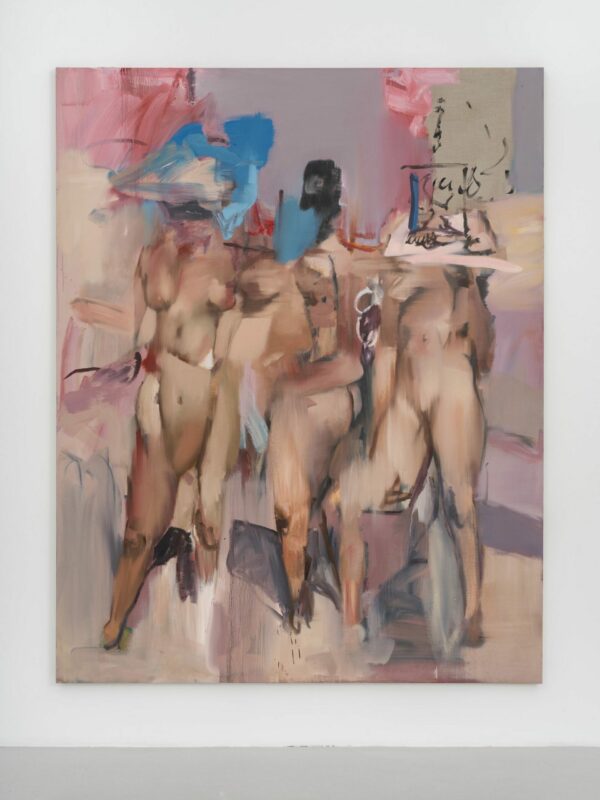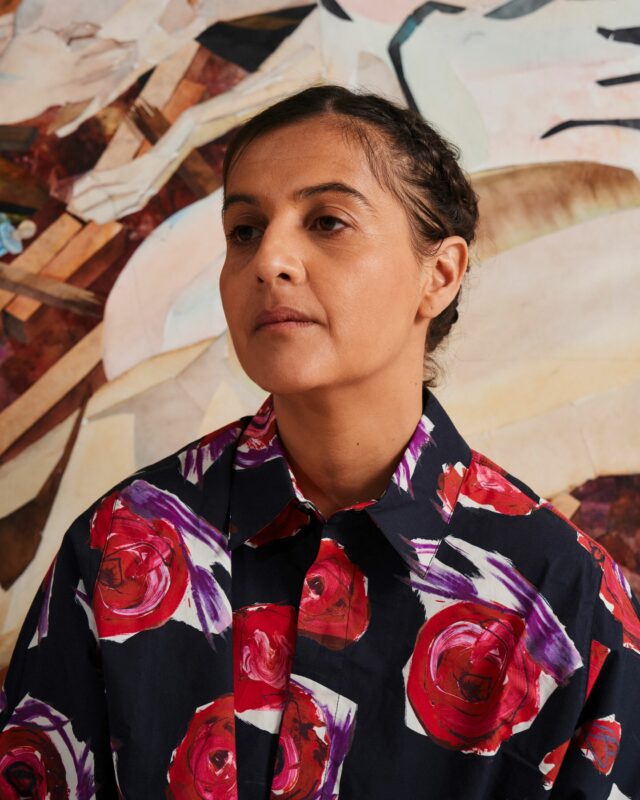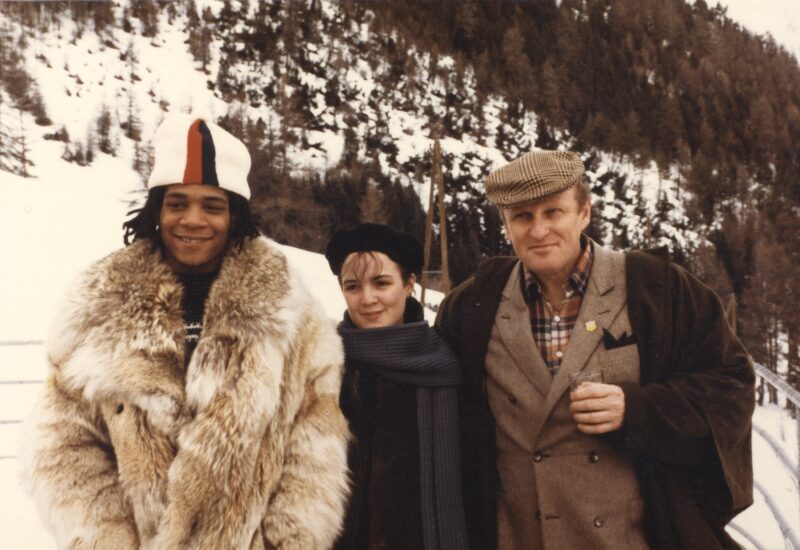
Self-portrait of Annie Leibovitz ©Annie Leibovitz Courtesy the artist and Hauser & Wirth
Following her early training at the San Francisco Art Institute, Leibovitz honed her talent into an acclaimed career in photojournalism and portraiture. Over the course of the past five decades, through a poetic body of far-reaching work Leibovitz has become an avatar of the changing cultural role of photography as an artistic medium. Her immense and varied output reveals a singular ability to merge the tactics of portraiture with profound humanism and sly wit.
On the heels of a major survey of Leibovitz’s early photographs presented at Hauser & Wirth Los Angeles this spring, the gallery will celebrate its representation of the artist by presenting a 63-part work by Leibovitz on its stand at Art Basel, opening 13 June. At almost two meters wide and one meter tall, ‘Driving Series, 1970-1984’ is a composite of portraits taken over many years, in which the subjects are captured at the wheel of a car – a scenario that has become a touchstone in the Leibovitz oeuvre and one that defines the essence of the American experience. ‘Driving Series, 1970-1984’ includes images of a number of notable figures and friends of the artist, including: Tina Turner, Hunter S. Thompson, Brian Wilson, Wim Wenders, Tom Wolfe, Marvin Gaye, Steve Martin, Martin Sheen, Lily Tomlin, O.J. Simpson, Mick Jagger, Carole King, and Bruce Springsteen.
Hauser & Wirth Partner and Vice President Marc Payot says:
‘We are delighted to be working with Annie Leibovitz. Through our projects together we hope to introduce ever greater and more diverse audiences worldwide to her contributions to the trajectories of American art. Leibovitz’s skill as a portrait maker places her within a lineage of such influential artists as Henri Cartier- Bresson, Richard Avedon, Andy Warhol, and August Sander. Like them, Leibovitz has developed an approach to photography that dovetails with – and advances – her medium’s evolution as a force for artmaking. We look forward to exploring new contexts for Leibovitz’s photographs, and to creating and facilitating exhibition opportunities and publishing projects for this marvelous artist.’
Hauser & Wirth has also announced that it will present a solo exhibition of works by Leibovitz at its space in the H Queen’s building in Hong Kong from 23 November 2019 to 8 February 2020.
The Hong Kong exhibition will be Hauser & Wirth’s second with Leibovitz and follows the inaugural collaboration in Los Angeles from 14 February through 14 April 2019, which brought together more than 4,000 photographs created between 1970 and 1983. In an installation curated by the artist, Leibovitz personally selected what she believed to be the most significant images taken during a formative period in her life and career. ‘Annie Leibovitz. The Early Years, 1970 – 1983: Archive Project No. 1,’ traveled to Los Angeles from the LUMA Foundation’s Parc des Ateliers in Arles, France, and garnered over 45,000 visitors in its two-month run at Hauser & Wirth Los Angeles. A similarly important exhibition by the artist – Leibovitz’s celebrated ‘Women: New Portraits’ – was exhibited across 10 cities over the course of 2016 and 2017 in a tour organized with the UBS Art Collection.
Exhibitions of Leibovitz’s work have appeared at museums and galleries across the globe, including the National Portrait Gallery and the Corcoran Gallery in Washington, D.C.; the International Center of Photography, New York NY; the Brooklyn Museum, New York NY; the Stedelijk Museum, Amsterdam, Netherlands; the Maison Europe?enne de la Photographie, Paris France; the National Portrait Gallery, London, UK; the Hermitage Museum, St. Petersburg, Russia; the Pushkin State Museum of Fine Arts, Moscow, Russia; and the LUMA Foundation’s Parc des Ateliers, Arles, France. In 2016 – 2017, the installation ‘Women: New Portraits’ was presented in London, Tokyo, San Francisco, Singapore, Hong Kong, Mexico City, Milan, Frankfurt, New York City, and Zurich.
Several collections of Leibovitz’s work have been published, including ‘Annie Leibovitz: Photographs’ (1983); ‘Annie Leibovitz: Photographs 1970 – 1990’ (1991); ‘Olympic Portraits’ (1996); ‘Women’ (1999), in collaboration with Susan Sontag; ‘American Music’ (2003); ‘A Photographer’s Life, 1990 – 2005’ (2006); ‘Annie Leibovitz at Work’ (2008; revised and updated in 2018), a first-person commentary on her career; ‘Pilgrimage’ (2011); an over-sized, limited collector’s edition of her photographs published by Taschen (2014); ‘Annie Leibovitz: Portraits 2005 – 2016’ (2017); and ‘Annie Leibovitz: The Early Years, 1970 – 1983’ (2018).
About the Artist
Annie Leibovitz was born in 1949 in Connecticut. She bought her first camera in the summer of 1968, when she was a student at the San Francisco Art Institute, and her early works are punctuated by images of the Bay Area landscape and photographs shot during drives the artist often took on the highways between San Francisco and Los Angeles. She switched majors from painting to photography, and while still a student, in 1970, she approached Rolling Stone magazine just three years after its inception, to offer a few of her pictures. Some of these were published, thus igniting her career as a photojournalist and launching what would develop into a symbiotic relationship between the young photographer and a magazine famous for reflecting the American zeitgeist. Leibovitz’s first major assignment was for a cover story on John Lennon.
Leibovitz became Rolling Stone’s chief photographer in 1973, and by the time she left the magazine, she had amassed 142 covers and published photo essays on scores of stories, including photographing reportage from the 1975 Rolling Stones tour. Moments of freedom and an unyielding imagination fed the evolution of Leibovitz’s photography. The monumental body of work made during her thirteen-year tenure at Rolling Stone blurred the lines between celebrity and civilian, interviewer and interviewee, artist and subject, dissolving the boundaries separating Leibovitz from those she captured in her images. Documenting fellow reporters and photographers in addition to their subjects, Leibovitz highlighted those generally hidden behind the camera and brought them to the forefront.
Leibovitz recorded major political moments of the Seventies in the United States, including the 1972 presidential campaign, which she covered with the writer Hunter S. Thompson. In a haunting photograph taken when President Richard Nixon resigned, on August 9, 1974, Leibovitz’s camera records his helicopter as it takes off from the White House lawn. Her immersion within the political landscape extended to photographs from the 1976 election, when figures such as Jerry Brown and Jimmy Carter seized national attention. The artist photographed the Democratic National Convention in New York City, showcasing candid moments with Dianne Feinstein and journalists such as Sally Quinn and Dan Rather. Leibovitz’s unobtrusive lens implicates both the photographer and her colleagues as significant actors in and contributors to cultural moments.
When traveling with the Rolling Stones to document their tour of the Americas in the summer of 1975, Leibovitz entered the band’s world to such a degree that only her camera served as a reminder of her identity. Her distinctive talent for fully immersing herself in varying environments enabled a depth of direct engagement with subjects that in turn revealed their true, honest, and perhaps most vulnerable selves.
By the early 1980s, Leibovitz began using a medium-format camera that produced square photographs and was appropriate for shooting set-up portraits with a strobe light. The planned portraits were based on a creative concept that most often emerged through personal collaboration with her subjects. Evidencing a level of uncanny intimacy. this relationship can be seen in one of her most celebrated photographs, in which a naked John Lennon clutches Yoko Ono. The portrait, made on December 8, 1980, was meant to serve as an intimate emblem of the couple’s relationship. When Lennon was killed just hours after the photo was taken, the image became a powerful visual memorial.
In 1983, when Leibovitz joined the staff of the revived Vanity Fair magazine, she was established as the foremost rock music photographer and an astute documentarian of the social landscape. At Vanity Fair, and later at VOGUE magazine, she developed a sweeping body of work comprising portraits of actors, directors, writers, musicians, athletes, and political and business figures, as well as fashion photographs. Leibovitz’s portraiture reflects a signature technique she developed early in her career, as she consciously and consistently fit style to subject through collaborating with her subjects, photographing them in their homes or in a location that meant something to them, where friends, lovers, children, and other personal markers might appear.
Annie Leibovitz’s prolific output and her inventive approach to photography itself position her distinctly within the traditions and trajectories of American portraiture during the twentieth century. Her unique photographic language dovetailed with – and advanced – the medium’s evolution as a force for art making. The singularity of her vision, which included combining portraiture with photojournalism in a way that captured historical and cultural touchstones in the United States and abroad, places her within a lineage of some of her personal heroes – artists like Andy Warhol and Richard Avedon, both innovators of their mediums. Influences such as Robert Frank and Henri Cartier-Bresson inspired Leibovitz to turn the tide on photography’s reception. Combining Frank’s highly personal and emotional style of photographic reportage with Cartier-Bresson’s Surrealist and even sculptural art photography, Leibovitz embraced her own inclination toward personal journalism. The artist’s large and distinguished body of work encompasses some of the most well-known portraits of our time.
Leibovitz is the recipient of many honors. In 2006 she was made a Commandeur in the Ordre des Arts et des Lettres by the French government. The previous year, in a compilation of the forty top magazine covers of the past forty years by the American Society of Magazine Editors (ASME), she held the top two spots (#1 for her 1980 photograph of John Lennon and Yoko Ono taken for Rolling Stone on the day Lennon was shot, and #2 for her portrait of pregnant actress Demi Moore for Vanity Fair). In 2009, she received the International Center of Photography’s Lifetime Achievement Award, ASME’s first Creative Excellence Award, and the Centenary Medal of the Royal Photographic Society in London. In 2012, she was the recipient of the Los Angeles Museum of Contemporary Art Award to Distinguished Women in the Arts and the Wexner Prize. In 2013 she received the Prince of Asturias Award for Communication and Humanities. She was the inaugural recipient of the San Francisco Museum of Modern Art Contemporary Vision Award in 2015. In 2018, she received a Lifetime Achievement Award for Excellence in the Arts from the National Museum of Women in the Arts. Leibovitz has been designated a Living Legend by the Library of Congress.
Leibovitz lives and works in New York.







